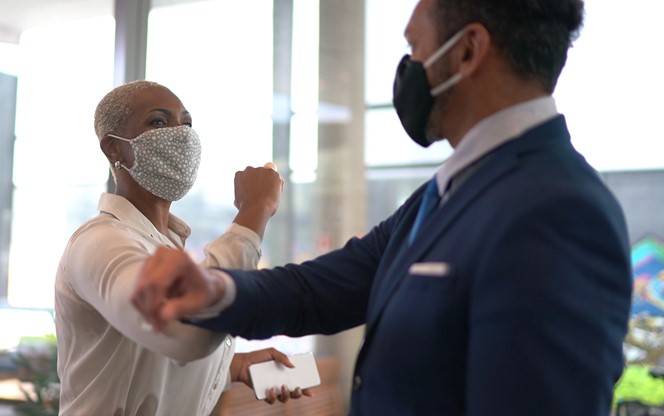

Articles | May 24, 2022
The pandemic introduced new anxieties into the workplace. While many workers have been performing their job duties in person throughout the pandemic, others are just now returning to the workplace, which is why, now more than ever, it’s important to be alert for signs of workplace stress.

Share this page
Our previous insight on pandemic-related employee stress covered five ways to address anxiety about returning to the office. This insight, which we’re publishing during National Mental Health Awareness Month, discusses top signs of employee stress — and what employers can do about it.
 The pandemic ushered in new stressors such as job instability, difficulty finding reliable childcare, fear of exposure to disease, increased job demands, feeling unable to keep up amidst constant change and societal polarization over masks and vaccinations. Whether an employee has been working remotely or in person throughout the last few years, these stresses impact day-to-day functioning.
The pandemic ushered in new stressors such as job instability, difficulty finding reliable childcare, fear of exposure to disease, increased job demands, feeling unable to keep up amidst constant change and societal polarization over masks and vaccinations. Whether an employee has been working remotely or in person throughout the last few years, these stresses impact day-to-day functioning.
Regardless of whether it originates from the workplace or from experiences outside of the job, stress affects productivity, attrition and employees’ sense of well-being and resiliency. Stress can lead to burnout, a syndrome where a person feels too emotionally and physically exhausted to do their job well.
Burnout has been attributed to about half of employee turnover, according to a study by Kronos Incorporated and Future Workplace. In a 2020 insight, we gave tips on how to help burned-out employees.
The connection between stress and burnout is a major reason why it’s important to address stressors early.
 Early in the pandemic, 13 percent of Americans disclosed in a survey that they increased substance use simply to cope with additional stress. For many, the substance use has morphed from a coping attempt into a source of stress. Employees may now be struggling to conceal or reduce intake of substances, a problem more easily kept hidden from peers and supervisors during remote work.
Early in the pandemic, 13 percent of Americans disclosed in a survey that they increased substance use simply to cope with additional stress. For many, the substance use has morphed from a coping attempt into a source of stress. Employees may now be struggling to conceal or reduce intake of substances, a problem more easily kept hidden from peers and supervisors during remote work.
Others are trying to adapt to new diagnoses of mental health. About 40 percent of U.S. adults now report signs of anxiety or depression, up from 10 percent pre-pandemic, according to the Kaiser Family Foundation. As normal routines resume and people continue returning to the workplace, these struggles won’t automatically resolve themselves. Instead, employees feel the burden of compensating for their mental health challenges to avoid drawing attention to themselves.
Substance use disorders and mental health diagnoses in others can also have an adverse impact on employees. Coping with loved ones and/or peers who are overusing substances or dealing with new mental health diagnoses is stressful.
Employees returning to the workplace after working remotely may face stressors they’ve never encountered before. In a recent survey about returning to the worksite after at-home work, more than half of respondents stated their experiences at work detract from their mental health. About one-third cite poor work-life balance and inadequate communication about new expectations as reasons for stress.
Additionally, remote work flexibility and increased childcare responsibilities spoiled sleep routines for many; employees might need to reestablish their old sleep hygiene techniques. Not only is inadequate sleep a stressor for many, but poor sleep decreases ability to withstand other stressors.
 While stress can be identified in remote employees, it’s often more noticeable when employees are in the workplace. Regardless of where an employee works, it’s crucial for supervisors, managers and HR professionals to be prepared to identify those who are struggling with stress and other behavioral health concerns.
While stress can be identified in remote employees, it’s often more noticeable when employees are in the workplace. Regardless of where an employee works, it’s crucial for supervisors, managers and HR professionals to be prepared to identify those who are struggling with stress and other behavioral health concerns.
An individual living with high stress may show one or more of these signs:
 If you believe there’s a behavioral health emergency, calling 911, as you would for a medical emergency, or the National Suicide Prevention Lifeline (800-273-8255) is essential. (The National Suicide Prevention Lifeline will be available throughout the United States until mid-July when it will be replaced by a new mental health crisis line: 988). Your employee assistance program (EAP or MAP) or behavioral health insurer may also offer ways to handle crisis situations. Find out by calling ahead of time or referencing your plan documents.
If you believe there’s a behavioral health emergency, calling 911, as you would for a medical emergency, or the National Suicide Prevention Lifeline (800-273-8255) is essential. (The National Suicide Prevention Lifeline will be available throughout the United States until mid-July when it will be replaced by a new mental health crisis line: 988). Your employee assistance program (EAP or MAP) or behavioral health insurer may also offer ways to handle crisis situations. Find out by calling ahead of time or referencing your plan documents.
For non-emergency situations, employers can respond to a stressed employee by offering strategies that resolve the stressor as well as resources on effective coping and resilience. A high-quality EAP can address both angles through a wide range of services.
For instance, they may assist in finding childcare or eldercare, provide coaching on sleep hygiene, or offer individual counseling or prescribing sessions with a licensed clinician for substance use disorder. The behavioral health plan benefits should include a variety of in-network providers with capacity to see new patients, as well.
Additionally, many EAPs offer training for supervisors and managers that includes how to identify and intervene when a worker is struggling.
As employers look to address workplace stress proactively going forward, they may find an overwhelming assortment of vendors and programs available. There are more than 10,000 digital mental health applications on the market today. Many vendors are approaching employers directly, which adds confusion to those trying to map out a comprehensive mental health strategy. Watch out for options that don’t reference specific clinical evidence-based best practices or that duplicate services you’re already receiving through a different program.
Consider additional health plan resources that provide personalized education and guidance, such as a dedicated nurse advocate or care navigation teams. Providing a high-quality, customized avenue to coordinate care increases engagement in mental health services and reduces the stress of navigating healthcare unassisted, according to an article published in Pediatrics.
Double-check that the services are sensitive to diversity, equity and inclusion considerations and attuned to how social determinants of health may affect outcomes. For instance, employees should have access to behavioral health counselors who have a similar ethnic and social background to themselves. (We discussed social determinants of health in a review of health plan news.)
Rest assured, addressing stress in the office doesn’t rest entirely upon hiring or procurement of a specialized vendor. Workplaces can foster healthy environments by encouraging employees to take vacation time to recharge, enlisting trained volunteers to act as mental health resources for workers and showcasing leaders who are candid regarding their own struggles and strategies in dealing with stress.
Leadership should empower supervisors to demonstrate flexibility and creativity to reduce workplace stressors. For instance, an employee may need to work remotely while coordinating care for a sick child. Employees may feel embarrassed to disclose stress and hesitant to ask supervisors for help, so leadership can reduce stigma by checking in with workers often, proactively reminding employees of available resources and encouraging appropriate work-life boundaries.
For more ideas on how to help employees combat workplace stress, see our insight, “Helping Individuals Cope in Response to COVID-19.”
Let’s have a conversation.
Chat with an Expert
Health, Mental Health

Organizational Effectiveness, COVID-19, Corporate

Consulting Innovation, COVID-19, Health, Mental Health
This page is for informational purposes only and does not constitute legal, tax or investment advice. You are encouraged to discuss the issues raised here with your legal, tax and other advisors before determining how the issues apply to your specific situations.
© 2024 by The Segal Group, Inc.Terms & Conditions Privacy Policy California Residents Sitemap Disclosure of Compensation Required Notices
We use cookies to collect information about how you use segalco.com.
We use this information to make the website work as well as possible and improve our offering to you.